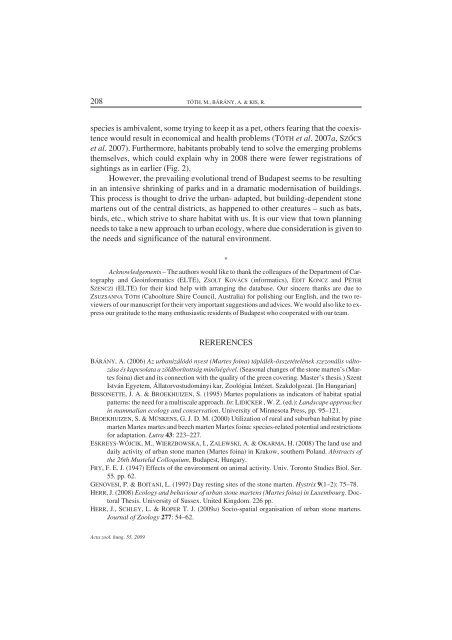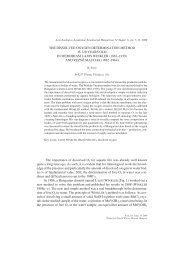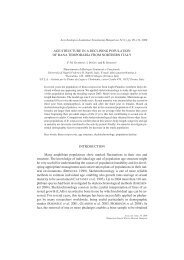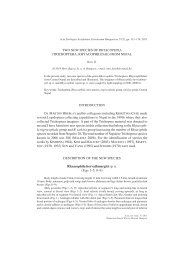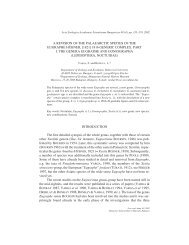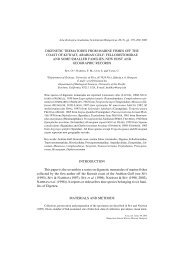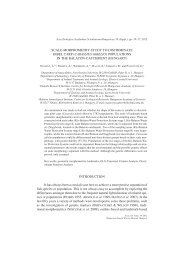AN EVALUATION OF STONE MARTEN (MARTES ... - ResearchGate
AN EVALUATION OF STONE MARTEN (MARTES ... - ResearchGate
AN EVALUATION OF STONE MARTEN (MARTES ... - ResearchGate
Create successful ePaper yourself
Turn your PDF publications into a flip-book with our unique Google optimized e-Paper software.
208 TÓTH, M., BÁRÁNY, A. & KIS, R.<br />
species is ambivalent, some trying to keep it as a pet, others fearing that the coexistence<br />
would result in economical and health problems (TÓTH et al. 2007a,SZŐCS<br />
et al. 2007). Furthermore, habitants probably tend to solve the emerging problems<br />
themselves, which could explain why in 2008 there were fewer registrations of<br />
sightings as in earlier (Fig. 2).<br />
However, the prevailing evolutional trend of Budapest seems to be resulting<br />
in an intensive shrinking of parks and in a dramatic modernisation of buildings.<br />
This process is thought to drive the urban- adapted, but building-dependent stone<br />
martens out of the central districts, as happened to other creatures – such as bats,<br />
birds, etc., which strive to share habitat with us. It is our view that town planning<br />
needs to take a new approach to urban ecology, where due consideration is given to<br />
the needs and significance of the natural environment.<br />
*<br />
Acknowledgements – The authors would like to thank the colleagues of the Department of Cartography<br />
and Geoinformatics (ELTE), ZSOLT KOVÁCS (informatics), EDIT KONCZ and PÉTER<br />
SZENCZI (ELTE) for their kind help with arranging the database. Our sincere thanks are due to<br />
ZSUZS<strong>AN</strong>NA TÓTH (Caboolture Shire Council, Australia) for polishing our English, and the two reviewers<br />
of our manuscript for their very important suggestions and advices. We would also like to express<br />
our gratitude to the many enthusiastic residents of Budapest who cooperated with our team.<br />
RERERENCES<br />
BÁRÁNY, A. (2006) Az urbanizálódó nyest (Martes foina) táplálék-összetételének szezonális változása<br />
és kapcsolata a zöldborítottság minőségével. (Seasonal changes of the stone marten’s (Martes<br />
foina) diet and its connection with the quality of the green covering. Master’s thesis.) Szent<br />
István Egyetem, Állatorvostudományi kar, Zoológiai Intézet. Szakdolgozat. [In Hungarian]<br />
BISSONETTE, J.A.&BROEKHUIZEN, S. (1995) Martes populations as indicators of habitat spatial<br />
patterns: the need for a multiscale approach. In:LIDICKER , W. Z. (ed.): Landscape approaches<br />
in mammalian ecology and conservation. University of Minnesota Press, pp. 95–121.<br />
BROEKHUIZEN,S.&MÜSKENS, G. J. D. M. (2000) Utilization of rural and suburban habitat by pine<br />
marten Martes martes and beech marten Martes foina: species-related potential and restrictions<br />
for adaptation. Lutra 43: 223–227.<br />
ESKREYS-WÓJCIK, M., WIERZBOWSKA, I., ZALEWSKI,A.&OKARMA, H. (2008) The land use and<br />
daily activity of urban stone marten (Martes foina) in Krakow, southern Poland. Abstracts of<br />
the 26th Mustelid Colloquium, Budapest, Hungary.<br />
FRY, F. E. J. (1947) Effects of the environment on animal activity. Univ. Toronto Studies Biol. Ser.<br />
55. pp. 62.<br />
GENOVESI, P. & BOIT<strong>AN</strong>I, L. (1997) Day resting sites of the stone marten. Hystrix 9(1–2): 75–78.<br />
HERR, J. (2008) Ecology and behaviour of urban stone martens (Martes foina) in Luxembourg. Doctoral<br />
Thesis. University of Sussex. United Kingdom. 226 pp.<br />
HERR, J., SCHLEY, L.&ROPER T. J. (2009a) Socio-spatial organisation of urban stone martens.<br />
Journal of Zoology 277: 54–62.<br />
Acta zool. hung. 55, 2009


